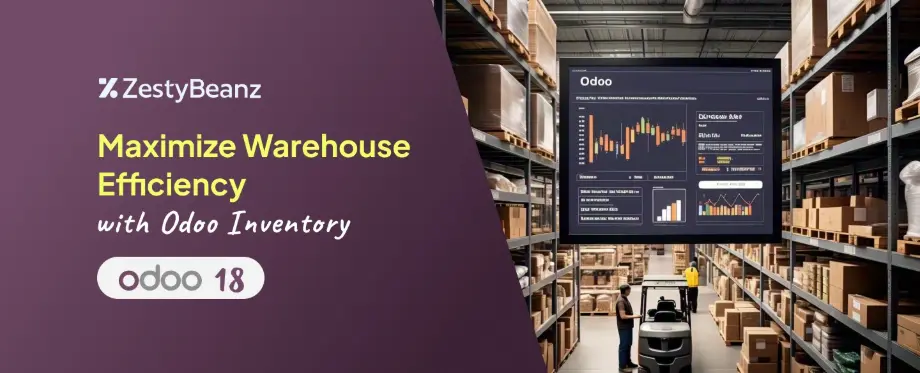
Maximize Warehouse Efficiency with Odoo Inventory
Introduction
The proper management of inventory and the warehouse plays a significant role in reducing losses that result from inefficient distribution and supply chain operations. Ironically, more than half of all businesses do not have inventory management systems or operate using manual methods to maintain their inventory and warehouse operations. To production or supply chain companies, the manner by which the inventory is managed and operational controls are assigned by the company leaders affects the overall efficiency and direction of their operations.
The impact of Covid-19 disrupted businesses across the globe, forcing organizations to adopt new business models and flexible strategies. Among these adaptations, effective inventory management became a critical factor in ensuring smooth operations. Interestingly, some business models thrived during this challenging period, thanks to their ability to incorporate adaptive strategies along with advanced tools and solutions.
Odoo ERP is the flexible and strong solution to perform well in hard times as well. Since it was invented during the early days of the 21st century, it became a high-end business software solution that works efficiently with all the industries. Being equipped with latest features and functionalities, Odoo provides all those tools which the business requires for smooth, efficient, and reliable management of their operations.
This blog will help you understand how the use of Odoo inventory management will facilitate the operations of a warehouse and of the company at large.
Before going into the inventory management of Odoo, it is important to know about the Odoo platform and how it works. Odoo ERP is designed to work flawlessly in a single platform, thus providing complete control and management through a unified system. Its centralized operational framework ensures streamlined inventory and database management, allowing for efficient data distribution, smooth communication, and easy information sharing across the organization.
Also, the modularity of Odoo does support the very specialized way one can carry business operations. And each module helps in specific facets regarding the company's workflow and management at every point. So far, let us also see how its inventory management mechanism can contribute more to warehouse working efficiency.
Odoo inventory management- Maximize warehouse efficiency
Odoo ERP has a robust inventory management module that integrates well with other modules on the platform, thus providing a unified approach to operational workflows. With advanced features like drop-shipping, cross-docking, double-entry inventory management, valuation adjustments, and more, Odoo's inventory management is an ideal solution for optimizing warehouse operations.
Challenges Faced Without a Proper Inventory Management System:
Organizations operating without an efficient inventory tool such as Odoo ERP often run into several other problems, among them:
A sales team ignorant of the inventory levels, therefore experiencing stock out and failing to fulfill multiple orders.
Procurement teams over ordering because they may not have current stock visibility-a problem that really hurts when goods are perishable.
Poor tracking and tracing with respect to in and out moving of products through the warehouse.
Limited or inefficient reporting capabilities, making analysis and decision-making slow and ineffective.
Odoo Inventory Management - Streamline Your Warehouse Operations
Odoo ERP provides a full-fledged, integrated inventory management module combined with all the other modules to ensure a unified approach towards operational management. Its advanced features include dropshipping, cross-docking, double-entry inventory, and various valuation techniques to make its inventory module an excellent solution for warehouse efficiency along with optimized workflows.
Some of the challenges that a business has to face without the possession of a robust system for managing the inventory, like Odoo, are:
Limited visibility for sales teams: Sales representatives lack real-time stock information, leading to product stock-outs and difficulty in fulfilling orders.
Overstocking by purchasing teams: Without accurate stock data, procurement teams may overorder, especially harmful for perishable goods.
Poor traceability and tracking: Inefficient tracking disrupts product movement within and outside the organization.
Time-consuming reporting: Generating accurate and detailed reports becomes challenging without dedicated tools, hindering analysis and decision-making.
These inefficiencies are an argument for the need for a proper inventory management solution. Let's see how Odoo Inventory Management can make your operations efficient and eliminate such inefficiencies:
Features and Benefits of Odoo Inventory Management
A standalone inventory management module that can be integrated with other related modules to support seamless operations.
Product Movement Control: Both inbound and outbound product transfer can be efficiently managed.
Centralized Inventory Data: A single source of truth for inventory details accessible to the sales and purchasing teams.
Barcode Integration: Configuring barcodes for products, service charges, promotions, and coupons simplifies invoicing and inventory tracking.
Automation: Automates the most essential inventory processes thereby saving manual labor.
Reorder Rules: Specified minimum and maximum stock with reordering signals to avoid both overstocking and stock outs.
Product routes: Configures movement routes with loading and unloading in a warehouse
Multiple Warehouse Management: It manages physical or virtual operations in multiple warehouses
Inventory forecasting: It uses Predictive analysis along with business intelligence tools for report generation and forecast.
Double-Entry System: Employ an effective double-entry system to manage storage in a better and more centralized data sharing.
Traceability Tools: Use barcodes, lot numbers, and dates of expiry to track products properly and trace back.
Auto Removal Features: Make sure that expired items are automatically removed to maintain standards.
Overstocking Prevention: Tools to measure stock levels in order to prevent overstocking
Advanced Operational Methods: Cross docking, dropshipping, and many other modern methods of inventory control.
HR Integration: Manage employees associated with inventory and distribution activities
Fleet Management Integration: Connect to the fleet management module to streamline delivery operations






























